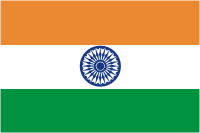Laxmi (pronounced "LACK-
shmee") or Lakshmi, is the wife goddess of Vishnu (who has many incarnations, including various forms of mammals, and eventually the flute-playing Krishna and honorable Ram) and is considered the goddess of wealth. Indians are naturally drawn to her and often make
puja (prayers and offerings) to
Laxmi. Their are a few festivals on the Hindu calendar that recognize her.

On arriving to
Mumbai (formerly called Bombay by the British) we decided to make our way toward the
Shri Mahalakshmi Temple - the most famous in town.
Mumbai is a city of 16 million people (or 160
lakhs, written as 1,60,00,000 if you are using the Arabian numerical system which is what is used in India). Just to put things into perspective, New York, the largest city in the US is about 10 million people and New Hampshire, our home state, is only about 1.2 million. However the United Nations ranks NYC as the third largest in the world, just ahead of
Mumbai if the surrounding urban areas are included.
It took us nearly two hours just to move a short distance in insanely heavy traffic. Upon arriving we walked the gauntlet of stalls selling offerings such as tapestries and garlands to decorate the idols within the temple, coconuts and
laddus (Indian sweets) for offerings, as well as some other basic
amenities for the huge crowds. We bought a plate of mixed offerings - some fresh cut flowers, coconuts, and
laddus to offer the goddess Lakshmi. Photography is not permitted within the temple, so I was only able to take a few snaps on the road there. Things got very crowded as we got closer (pilgrims were divided in lines by gender, so Jessie, Erin and I got split up) so I had to pick Evan up and push my way forward in order to pass my offering plate to one of the
Brahman (priests) who assembled the offerings in neat piles. He then gave me a half coconut in return, which I was eventually instructed to share with my neighbors.
It was nice way to start three days in the biggest city I have ever been to.
 KVT recenlty hosted its "fancy dress competition" with many of the students taking on the personas of famous people. Mahatma Ghandi and the Statue of Liberty were in attendance, to name a few.
KVT recenlty hosted its "fancy dress competition" with many of the students taking on the personas of famous people. Mahatma Ghandi and the Statue of Liberty were in attendance, to name a few. This competitive academic culture (for example, students are often listed in order of class rank) sometimes reaches levels that seem too extreme from a western perspective) students were graded and ranked on what would otherwise seem like a light-hearted event.
This competitive academic culture (for example, students are often listed in order of class rank) sometimes reaches levels that seem too extreme from a western perspective) students were graded and ranked on what would otherwise seem like a light-hearted event.































